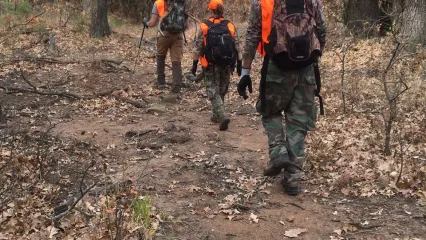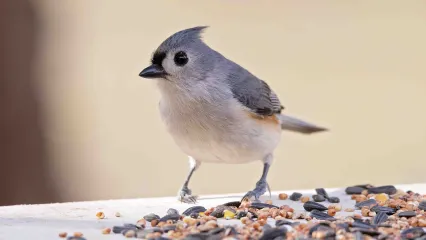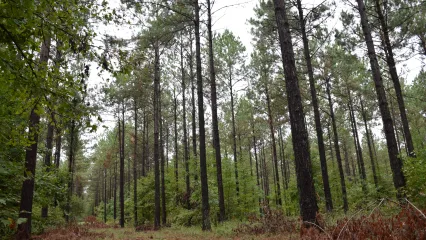Attention Non-Residents
The Oklahoma Wildlife Conservation Commission adopted new rules in 2025 that require non-residents accessing certain Oklahoma public hunting and fishing areas to check in and out of the area. By checking in and out of these areas, hunters, anglers, shooters, birdwatchers, hikers and any other users can help the Wildlife Department better understand how the area is being used. There is no additional cost associated with checking in or out of an area. There is no limit to the number of check ins for an individual in a year.

Contacts
Area Details
Mountain Park WMA covers 5,000 acres in Kiowa County in southwest Oklahoma. The area is on the north and west sides of Tom Steed Reservoir which is north of Snyder on Hwy 183. Mountain Park WMA is a mixture of grassland, agriculture fields and areas of scrub mesquite. The agriculture fields consist of winter wheat and milo. Wetland units are located on the northwest side of the area. The average annual rainfall for the area is about 26 inches.
From Mountain Park: 7 miles north on U.S. Hwy 183. The WMA is located mainly north and west of this point and around the lake to the west.
- Quail: Bobwhite quail are present in fair numbers but are highly sought after.
- Deer: White-tailed deer are present in fair numbers.
- Rabbit: Cottontails are present in good numbers.
- Furbearers: Coyote, bobcat and raccoon are available.
- Dove: Often present in good numbers in vicinity of managed feeding fields.
- Waterfowl: Large numbers of wintering geese and ducks are usually present during migration.
- Turkey: Rio Grande Turkeys are present in low numbers.
- Bald Eagle: Eagles winter on nearby Wichita Mtns. Wildlife Refuge and frequent Tom Steed lake.
- Shorebirds: Frequent the lake shores and wetland units during fall and spring migrations.
Approximately 2,000 acres is in an agriculture lease program to provide wildlife feeding areas. A 320 acre wetland unit is managed for waterfowl through agriculture plantings and native wetland plant enhancement. Trees are planted to provide wildlife cover and nesting habitat.
Three designated primitive camping areas are offered on the area. RV Camping is available at the Great Plains State Park, (580) 569-2032.
Tom Steed Lake is known best for its crappie and walleye fishery. It also has opportunities for hybrid striped bass, catfish and black bass.
All shotgun hunting is restricted to federally approved nontoxic shot on the WDU portion.
Closed Seasons
Same As Statewide Seasons
Seasons w/ Special Restrictions
- Pursuit with Hounds for Furbearers, Predator/Furbearer Calling
Closed during the first nine days of deer gun season.
- Duck, Merganser and Coot
Hunting hours for waterfowl close at 1 p.m. daily on the WDU portion.
- Trapping
Open to water sets, live box traps and enclosed trigger traps only through Jan 31. Open same as statewide Feb 1 through end of February.
- Turkey Spring, Youth Turkey Spring
One-tom limit; seasons combined. Hunting hours close at 7:00 p.m. daily.
- Quail
Closed during the first nine days of deer gun season. Closed to non-resident hunting February 1-15.
Hunter and angler camping is allowed in designated areas.
Closed to all air-driven watercraft on WDU portion.
Lawton Fort Sill Chamber of Commerce and Industry
629 C Avenue Lawton OK 73501
580-355-3541
1-800-872-4540
www.lcci.org
Great Plains Country
114 South 9th St, Suite A Frederick OK 73542
580-335-5999
gpc@greatplainscountry.com
www.greatplainscountry.com
Oklahoma Tourism and Recreation Department
Post Office Box 52002
Oklahoma City, OK 73152-2002
(800) 652-6552 or (405) 521-2409
www.travelok.com
Apprentice Designation: A Learner's Permit for Hunting
Hunter education has greatly reduced hunting accidents, but if you can’t complete a course right away, the apprentice designation allows you to hunt under supervision. It works like a learner’s permit, giving you the chance to gain real experience safely until you finish hunter education.
Exploring the New Herron Family WMA
The new Herron Family WMA is more than 17,000 acres of hunting land, it is also adventure, access, conservation, and tradition. Thanks to a unique partnership, Oklahoma residents now have a new place to chase deer, call turkeys, hear quail, and pass on the outdoors to the next generation.


